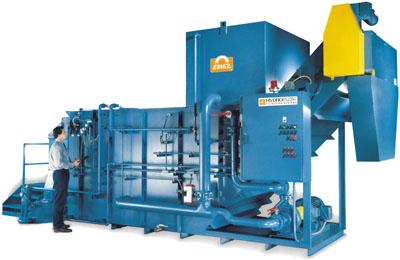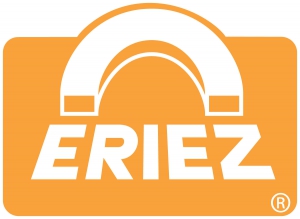
The patented STAR Filter from Eriez HydroFlow are for the machine tool industry. These simple, rugged filters incorporate advanced features to eliminate problems common with rotating vacuum filters, according to the company.
Typically installed as central systems with flow rates above 250 GPM and filtration to oneµm, the STAR Filter uses a centrifugal pump to draw liquid through a permanent media element with an optional feed of cellulose filter-aid for extra fine filtration. Their unique design enables the maximum filtration area in the most economical use of space.
Each STAR element is precision built and interchangeable. Individual panels are positioned to provide a vertical drop to dislodge the filter cake, which allows a gentle yet thorough settling of the vacuum compressed filter cake. Each STAR element can be removed for inspection and reinstalled into the STAR seal without concern for misalignment or proper sealing.
The element's star shape and the filter panel's compact rectangular design maintains structural integrity after removal from the filter. With the end caps removed, cleaning on both sides of the filter panels is simple, unlike the circular construction used in drum filters.
STAR Filters are successfully utilized in a broad variety of applications that require a high level of filtration, including grinding, machining, superfinishing and rolling mills working steel, carbide, glass, ceramic, aircraft alloys, cast-iron and aluminum. "Our HydroFlow STAR Filters have proven to be real workhorses delivering high pressure, ultra-clean coolant to our 21 precision grinding centers," says Scott Stang, Manufacturing Technology Manager at Hi-Tek Manufacturing.
Contact Details
Related Glossary Terms
- alloys
alloys
Substances having metallic properties and being composed of two or more chemical elements of which at least one is a metal.
- centers
centers
Cone-shaped pins that support a workpiece by one or two ends during machining. The centers fit into holes drilled in the workpiece ends. Centers that turn with the workpiece are called “live” centers; those that do not are called “dead” centers.
- coolant
coolant
Fluid that reduces temperature buildup at the tool/workpiece interface during machining. Normally takes the form of a liquid such as soluble or chemical mixtures (semisynthetic, synthetic) but can be pressurized air or other gas. Because of water’s ability to absorb great quantities of heat, it is widely used as a coolant and vehicle for various cutting compounds, with the water-to-compound ratio varying with the machining task. See cutting fluid; semisynthetic cutting fluid; soluble-oil cutting fluid; synthetic cutting fluid.
- feed
feed
Rate of change of position of the tool as a whole, relative to the workpiece while cutting.
- grinding
grinding
Machining operation in which material is removed from the workpiece by a powered abrasive wheel, stone, belt, paste, sheet, compound, slurry, etc. Takes various forms: surface grinding (creates flat and/or squared surfaces); cylindrical grinding (for external cylindrical and tapered shapes, fillets, undercuts, etc.); centerless grinding; chamfering; thread and form grinding; tool and cutter grinding; offhand grinding; lapping and polishing (grinding with extremely fine grits to create ultrasmooth surfaces); honing; and disc grinding.

